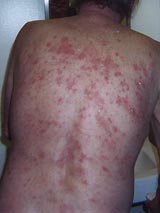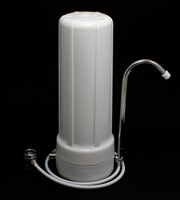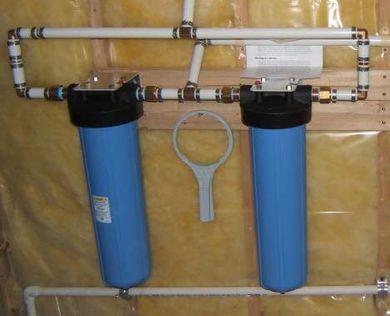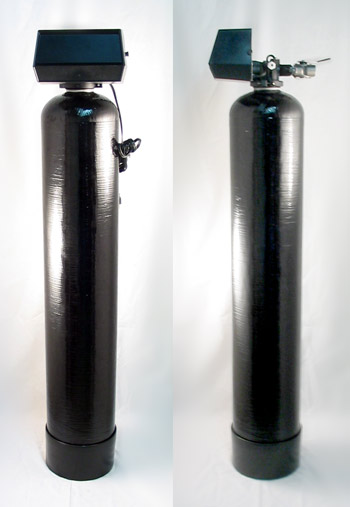Special Mid-Month Issue May 15, 2012 |
|---|
Chloramines: Myth and Reality
by Gene Franks
I live in a city that treats its drinking water with chloramine. I don't know when the switch from chlorine to chloramine was made, and most of my fellow citizens aren't even aware that the disinfectant in the water is chloramine. Everyone calls it chlorine.
These days when cities make the switch from chlorine to chloramine the change seldom goes smoothly. There is often organized opposition and vociferous objection, frequently with exaggeration and questionable reasoning from both sides.
Here is a statement from a New Jersey water supplier that is in process of making the change from chlorine to chloramine. It addresses or at least hints at most of the tender issues in the debate.
VOORHEES, N.J., May 09, 2012 (BUSINESS WIRE) -- Later this month, New Jersey American Water customers should notice less chlorinated smell and taste in their drinking water while continuing to receive reliable water service that meets or exceeds state and federal standards. Beginning the week of May 28, New Jersey American Water will be changing its water treatment disinfectant for customers in Monmouth and Ocean Counties from free chlorine to chloramine, which is a mixture of chlorine and ammonia approved by the New Jersey Department of Environmental Protection and the U.S. Environmental Protection Agency (EPA).
The switch to chloramine is necessitated by new regulations implemented by the EPA to reduce "disinfection byproducts" associated with chlorinated drinking water. As a disinfectant, chlorine reacts with naturally occurring organic materials found in raw water and the byproducts of that reaction could be attributed to some health risks. Chloramine is not as reactive with organic materials, and thereby produces less disinfection byproducts.
"The use of chloramine is new to our customers in Monmouth and Ocean Counties, but it is a water treatment process that has been in use for 90 years. Chloramine is used in other areas of New Jersey American Water's distribution system and is common across the U.S. and other utilities in New Jersey," said Steve Schmitt, New Jersey American Water's vice president of operations. "Chloramine is a very effective disinfectant that allows us to maintain high-quality, reliable water service for customers as well an exceptional record of meeting state and federal standards."
New Jersey American Water advises kidney dialysis patients to consult their physicians to determine what modifications should be made in their treatment process to filter chloramine-treated water. Water treated with chloramine is safe for dialysis patients to ingest. Fish owners should also take precaution with the changeover to chloramine as it may be toxic to fish. Products can be obtained at pet stores that will remove chloramine from tap water prior to filling fish tanks.
New Jersey American Water has established a website that provides customers with more information about chloramine at www.njchloraminefacts.com .
Truths and Misconceptions--Chloramine in a Nutshell
Chloramine isn't new. As stated above, it has been used to treat public water supplies for 90 years--since about 1920 to be exact. (Chlorination began in the US in 1908. Treatment with chloramine goes back almost as far.)
Chloramine is a mixture of chlorine and ammonia.
Chloramine is far less reactive than chlorine. Therefore, it takes longer to work and it doesn't do as good a job as chlorine for some purposes. Consequently, it is usually dosed in larger quantities than chlorine.
Chloramine is lethal to fish. Aquarium owners must take care to keep it out of ponds and aquariums.
Chloramine must be removed from water used for dialysis.
 |
|---|
| Chloramine also appears to cause varying degrees of skin discomfort that takes the form of itching and rashes in a small percentage of the population. Some people complain of being unable to bathe in chloramine-treated water. Anti-Chloramine websites often feature pictures like the above. |
Chloramine is attractive to water suppliers because it does not react as readily with organic matter in the water to create toxic by-products that are variously called DBPs (disinfection by-products) and THMs (trihalomethanes). These by-products are regulated by the EPA.
Chloramine has the added advantage of being more stable than chlorine--another reason that water suppliers like it.
There is wide belief, probably inspired by organizations that oppose chloraminization, that chloramine is impossible to remove from water. This is not true.
Some websites state that effective chloramine removal products cost up to $15,000 to purchase and thousands of dollars per year to maintain. This, also, is untrue.
What is true is that most of the technologies that remove chlorine also remove chloramine. Chloramine, however, is much more difficult to treat and requires more contact time with filter. Therefore, oversized treatment beds and/or reduced service flow rates are usually required.
For residential applications, the best treatments for chloramines are granular catalytic carbon, granular standard bituminous carbon (in oversized beds), carbon block filters, and ascorbic acid.
Of these, ascorbic acid is now mainly used in shower filters and dechloriminating bath tablets, although before the development of catalytic carbon, ascorbic acid (Vitamin C) was used as a pretreatment for dialysis. Ascorbic acid is still used in large, industrial applications for chloramine reduction.
For residential drinking water or whole house treatment, catalytic carbon is the unquestioned preferred treatment for chloramines. Catalytic carbon is especially formulated and processed for reduction of chloramines.
Catalytic carbon breaks the bond between chlorine and ammonia and converts the chlorine to harmless chloride.
Standard granular carbon reduces chloramine as well as catalytic carbon and by the same method. It just does it much more slowly. With standard carbons, filter bed sizes must be increased dramatically.
Carbon block filters, made with standard carbon, can be extremely effective at chloramine reduction, but, again, the slower the flow rate the better. Carbon blocks are effective for drinking water chloramine reduction and they can also be used in whole house chloramine treatment. Multiple carbon blocks often work best with chloramines.
 |
|---|
| In spite of gloomy assertions that chloramine removal is impossible, we've found that our simplest drinking water filter, the Model 77 countertop shown above, does quite a good job at chloramine reduction. Using the standard MatriKX CTO Plus cartridge and running water at a moderate flow rate, Model 77 reduces the 2 ppm chloramine in our local tap water to a level that isn't detected on standard test strips. Filter cartridges should be changed more frequently when treating chloramine. A double version of the countertop gives added chloramine efficiency and longer cartridge life. |
If standard carbon is used to reduce chloramine, the rule is the more carbon the better. Double filters are better than single, and triple are better than double.
 |
|---|
| Many of our local customers use a single 4.5" X 20" filter for whole house chloramine reduction. The split version shown above, where each filter handles half the flow, is an excellent chloramine arrangement. Our "compact whole house" filter now uses the MatriKX CTO as the standard filter. We also offer the Pentek Chlor Plus cartridge for this unit. It is designed specifically for chloramine reduction. |
Tank-style filters work best for chloramine reduction with catalytic carbon. Sizing such filters adequately, so that most of their operation can be done within recommend service flow rates, greatly increases the service life of the catalytic carbon. We have both backwashing and In/Out Upflow filters with catalytic carbon for maximum chloramine performance.
 |
|---|
| Two views of our best whole house chloramine product. We call it the Chloramine Catcher. |
Overview
The discussion of chloramine reduction is of necessity vague. Except in controlled industrial situations, estimating or guaranteeing the percentage of reduction of chloramine or the life expectancy of the filter media is impossible. There are far too many variables.
Reduction of chloramines from city water is a commonly misunderstood issue. For those unfamiliar with the details of water treatment, there is often an expectation that there is a "filter" for every contaminant that specifically identifies that contaminant and, as if by magic, "takes it out." A frequent question is "How much does it take out?" It isn't quite as simple as that, especially with "problem contaminants" like chloramines.
The point is that if your city is adopting chloramines as its disinfectant, the sky isn't falling. The sun will still come up tomorrow morning. You may have to go to a bit more expense maintaining your water filter, but the same products that worked with chlorine will work with chloramine--you just may have to upgrade your system a bit, and service it a little more often.
In this discussion we didn't tackle the thorny question of what happens to the ammonia when chloramine is treated. More of that in a future issue.
More information about chloramines:
http://www.purewateroccasional.net/wtichloramine.html
http://purewatergazette.net/blog/things-you-should-know-about-chlorine-and-chloramines/
The Pure Water Occasional is a project of Pure Water Products. Please visit our websites: Main Website: www.purewaterproducts.com This site features our full range of products, plus instructions, technical articles, product manuals, and more. The Occasional's Website: www.purewateroccasional.net. In addition to archiving back issues of the email Occasional, this site houses a sizeable section about water contaminants, a "how things work," series, a new products section, a glossary of water treatment terms, and, "much, much more." Other Pure Water Products Sites: www.purauv.com To contact us by phone, please call 940 382 3814.
|
|---|